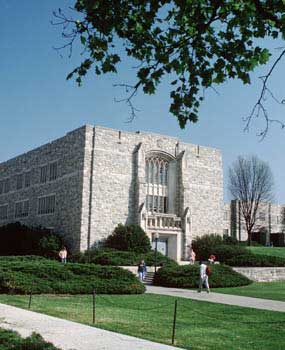Norris Hall to begin phased reoccupation

In conjunction with the faculty and leadership of the College of Engineering and the Department of Engineering Science and Mechanics (ESM), Virginia Tech President Charles Steger has decided that phased re-use of the building will begin June 18.
The building will be dedicated to offices and laboratories for the Engineering Science and Mechanics and Civil and Environmental Engineering departments, which had been the primary building occupants prior to April 16.
“I received dozens of letters and e-mail notes from faculty, staff, students, alumni, and friends expressing their views on the disposition of the building,” said Steger. “Dean Benson provided me with a set of recommendations and together we met with the ESM faculty, the overwhelming majority of whom are eager to return to Norris Hall. After considering all points of view that were offered, I determined the best course of action to enable the College of Engineering to continue its healing was to move forward with phased re-use of the building.”
In the wake to the tragic events of April 16 in Norris Hall, the building has been vacant while the university determined the most appropriate next steps for building usage. At about 70,000 gross square feet, Norris Hall represents a significant resource for Virginia Tech.
In light of the trauma experienced by the university community, there will be no general assignment classrooms in Norris.
“We feel that this is the most appropriate decision for getting the college moving again while recognizing the gravity of events that occurred here,” said Ed Nelson, associate dean of engineering and chair of a task force reviewing options for the dean and President Steger.
“The sophisticated and expensive laboratories can not be moved and are essential to the work of ESM, and therefore the college,” said Dick Benson, dean of the College of Engineering. We have literally dozens of graduate students whose work is frozen in time and unable to move on to jobs or complete their research.”
In addition to its own work, ESM is a “service department.”
“The productivity and even the accreditation of other engineering programs – most notably civil and environmental engineering, materials science and engineering, and ocean engineering – depend on ESM-maintained laboratories in Norris Hall,” said Benson.
A plan is being developed to convert the former general assignment classrooms in Norris to other uses. Since the building will no longer be multi-use and will be devoted solely to departmental activities, the ESM department will, over the long term, consolidate offices and labs currently in three other buildings.
The university is considering several options for long term renovation, which activates the capital planning process. The Office of the University Architect will begin a feasibility study this summer to evaluate best long term uses.
Because the building has been of intense public interest and because there may be sightseers or visitors disrupting the normal flow of building activity, building access will be limited for an indeterminate time to university employees, students, and department or college visitors. Security officers will be posted within the building to check Hokie Passport identification.
Entrance will be limited to the Holden-Norris tunnel entrance. The building will be unlocked from 7 a.m. to 5:30 p.m. on weekdays, locked on weekends, and accessible by key during off-hours.
“We in the university, college, and department leadership fully understand the difficulty some individuals may have reentering Norris and will make accommodations on a case by case basis. The university has made arrangements for continued counseling at any desired level – individual or group for faculty, staff, or students,” says Benson.
Ishwar Puri, ESM department head said, “I have discussed this decision with many throughout the department and college, as well as with university leadership, and we are cognizant of the potential mental roadblocks. Yet generally, the faculty and graduate students are not only willing but anxious to return to their offices, labs, and research and not allow this tragedy to stop the great work and learning of this university.”
The Dean of Engineering Office, which had been located on Norris’s third floor and other locations on campus, has been temporarily relocated to Durham, Torgersen, and Whittemore Halls and the Gateway Center. It too, ultimately will be consolidated into a single location.
The university will be erecting a memorial somewhere on campus in a location more suited to reflection and testimonial.
“We would prefer to see a memorial elsewhere on campus with fitting tribute focusing on the lives, not the passing, of our colleagues, friends, and students,” said Benson.
Norris Hall is named for Earl B. Norris who served as dean of engineering for 24 years (1928-1952).




